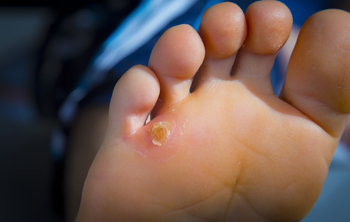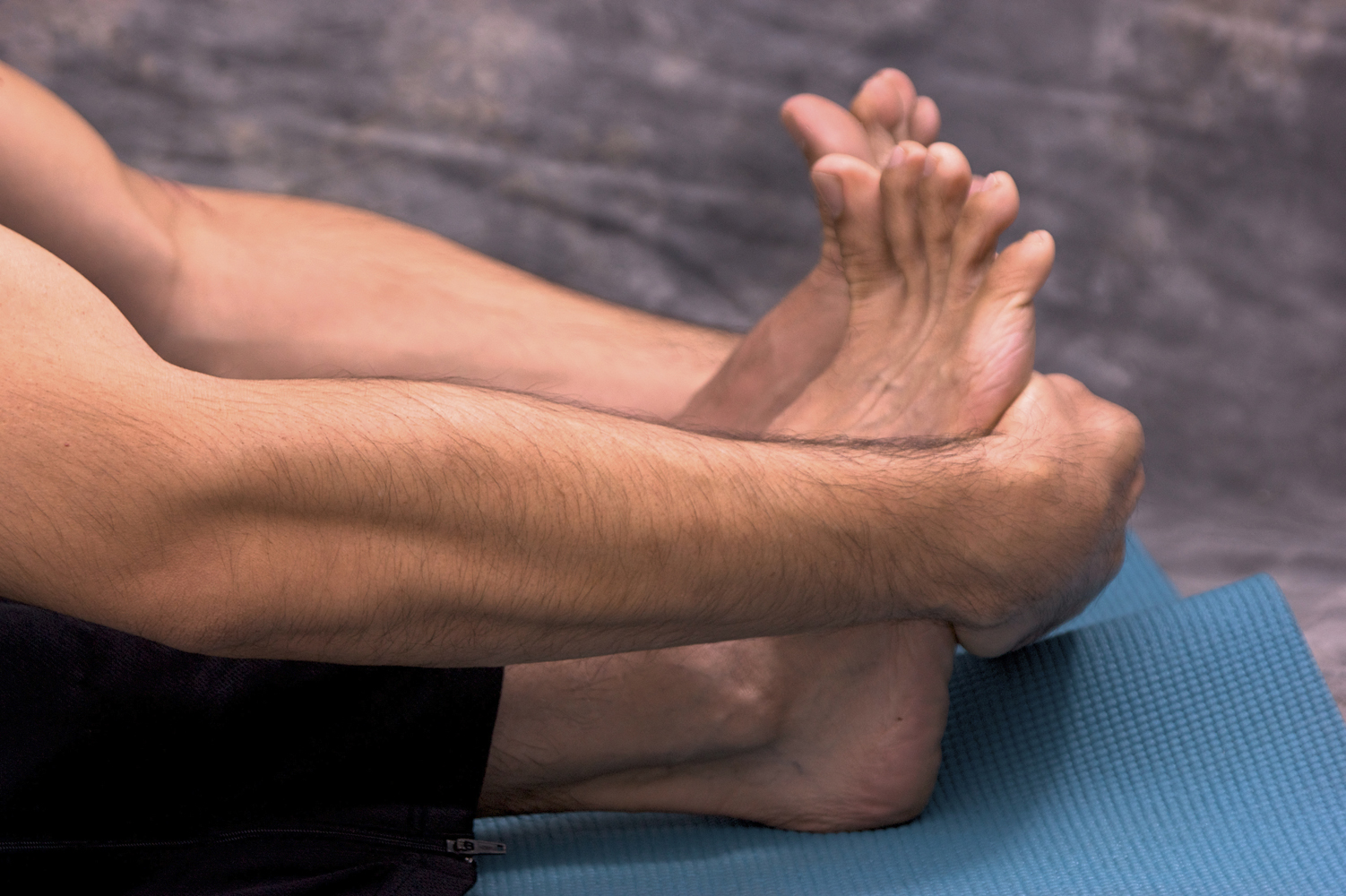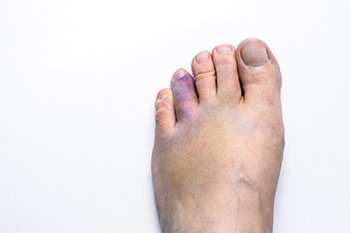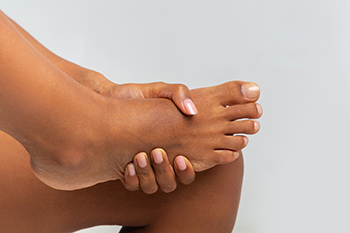3320 North Buffalo Drive
Suite 107
Las Vegas, NV 89129

Corns, small and often painful thickened areas of skin, can manifest in different forms on the feet, causing discomfort and irritation. Hard corns typically develop on the top or sides of toes, forming dense and compact layers of dead skin. Soft corns thrive in moist areas between toes, adopting a softer texture due to increased hydration. Seed corns are tiny, often painless corns found on weight-bearing areas on the bottom of the feet. Vascular corns, appearing as a dark spot with tiny blood vessels, are less common but can be more painful. Understanding these distinct types of corns aids in their proper identification and subsequent management. A podiatrist can successfully treat any type of corn that may have developed. If you have a corn on your foot, it is suggested that you consult a podiatrist who can offer effective remedies and prevention techniques.
Corns can make walking very painful and should be treated immediately. If you have questions regarding your feet and ankles, contact one of our podiatrists of Summerlin Foot & Ankle. Our doctors will treat your foot and ankle needs.
Corns: What Are They? And How Do You Get Rid of Them?
Corns are thickened areas on the skin that can become painful. They are caused by excessive pressure and friction on the skin. Corns press into the deeper layers of the skin and are usually round in shape.
Ways to Prevent Corns
There are many ways to get rid of painful corns such as:
Treating Corns
Although most corns slowly disappear when the friction or pressure stops, this isn’t always the case. Consult with your podiatrist to determine the best treatment option for your case of corns.
If you have any questions please feel free to contact our office located in Las Vegas, NV . We offer the newest diagnostic and treatment technologies for all your foot and ankle needs.

Promoting overall well-being involves not only physical exercise but also caring for often-neglected areas like the feet. Incorporating effective foot stretches into your routine can contribute significantly to flexibility and foot health. Begin with a simple toe stretch by sitting back on your heels and gently pressing the toes into the ground, providing a soothing stretch for the foot arches. Additionally, calf stretches can be achieved by propping the ball of your foot against a wall and leaning forward. To relieve tension in the ankles, rotate them clockwise and counterclockwise while seated. Finally, the classic seated forward bend can also benefit your feet by stretching the Achilles tendon. These stretches, performed consistently, enhance circulation, reduce stiffness, and contribute to overall foot comfort. If you would like more information about what type of foot stretches to perform, it is suggested that you consult a podiatrist.
Why Stretching Is Important for Your Feet
Stretching the feet is a great way to prevent injuries. If you have any concerns with your feet consult with one of our podiatrists from Summerlin Foot & Ankle. Our doctors will assess your condition and provide you with quality foot and ankle treatment.
Stretching the Feet
Stretching the muscles in the foot is an important part in any physical activity. Feet that are tight can lead to less flexibility and make you more prone to injury. One of the most common forms of foot pain, plantar fasciitis, can be stretched out to help ease the pain. Stretching can not only ease pain from plantar fasciitis but also prevent it as well. However, it is important to see a podiatrist first to determine if stretching is right for you. Podiatrists can also recommend other ways to stretch your feet. Once you know whether stretching is right for you, here are some excellent stretches you can do.
It is best to go easy when first stretching your foot and work your way up. If your foot starts hurting, stop exercising to ice and rest the foot. It is advised that you then see a podiatrist for help.
If you have any questions, please feel free to contact our office located in Las Vegas, NV . We offer the newest diagnostic and treatment technologies for all your foot care needs.

Broken toes, a common yet painful condition, can affect a range of individuals, each vulnerable in their unique ways. Those engaging in physically demanding activities, such as athletes or individuals with high-impact occupations, are at an elevated risk due to the increased likelihood of accidental trauma. Individuals with weakened bones, often associated with conditions like osteoporosis, also face higher susceptibility to fractures from minor injuries. Accidents at home, whether stubbing a toe against furniture or dropping a heavy object on it, pose a risk for anyone. Symptoms of a broken toe include immediate pain, swelling, and bruising, accompanied by difficulty moving the affected toe. Sometimes, a visible deformity or a cracking sound may accompany the injury. Recognizing these symptoms is vital for seeking prompt medical attention and ensuring proper care to facilitate optimal healing. If you have broken your toe, it is suggested that you visit a podiatrist as quickly as possible who can appropriately treat this condition.
A broken toe can be very painful and lead to complications if not properly fixed. If you have any concerns about your feet, contact one of our podiatrists from Summerlin Foot & Ankle. Our doctors will treat your foot and ankle needs.
What to Know About a Broken Toe
Although most people try to avoid foot trauma such as banging, stubbing, or dropping heavy objects on their feet, the unfortunate fact is that it is a common occurrence. Given the fact that toes are positioned in front of the feet, they typically sustain the brunt of such trauma. When trauma occurs to a toe, the result can be a painful break (fracture).
Symptoms of a Broken Toe
Generally, it is best to stay off of the injured toe with the affected foot elevated.
Severe toe fractures may be treated with a splint, cast, and in some cases, minor surgery. Due to its position and the pressure it endures with daily activity, future complications can occur if the big toe is not properly treated.
If you have any questions please feel free to contact our office located in Las Vegas, NV . We offer the newest diagnostic and treatment technologies for all your foot and ankle needs.

Plantar fibroma, a condition affecting the feet, involves the formation of non-cancerous, fibrous tissue growths within the plantar fascia, which is the ligament spanning the bottom of the foot. These nodules, often slow-growing, manifest as small lumps beneath the skin, leading to discomfort and potential limitations in foot mobility. The exact cause of plantar fibromas remains elusive, but factors such as genetics and trauma to the plantar fascia are considered contributory. The condition tends to be more prevalent in individuals with a family history of plantar fibromas, emphasizing a genetic predisposition. Additionally, repetitive stress or injury to the plantar fascia, often incurred through excessive standing or walking, can trigger the development of these fibrous nodules. Understanding the definition and potential causes of plantar fibroma lays the foundation for informed discussions with podiatrists and the exploration of appropriate management strategies for this relatively common yet nuanced foot condition. If you have these kinds of growths on your feet, it is suggested that you speak with a podiatrist who can correctly diagnose and treat plantar fibromas.
A plantar fibroma may disrupt your daily activities. If you have any concerns, contact one of our podiatrists of Summerlin Foot & Ankle. Our doctors can provide the care you need to keep you pain-free and on your feet.
Plantar Fibroma
A plantar fibroma is a fibrous knot in the arch of the foot. It is embedded in the plantar fascia which is a band of tissue that extends from the heel to the toes along the bottom of the foot. There can be multiple plantar fibromas in the feet at the same time. There are no known causes for this condition. If you have a plantar fibroma, there will be a bump in the arch of your foot that cannot be missed. Any associated pain is most often due to a shoe rubbing against the nodule. Non-surgical options, such as steroid injections, physical therapy, and orthotics should be tried first. Surgery is a last resort and is the only thing that will remove a plantar fibroma entirely. Consult with a podiatrist for a proper diagnosis and to determine the treatment regimen that is right for you.
What Causes a Plantar Fibroma?
While there are no specific causes identified, a plantar fibroma can possibly come from genetic predisposition or the formation of scar tissue that forms from healing the tears in the plantar fascia.
What Are the Symptoms of a Plantar Fibroma?
There will be a noticeable lump in the arch of the foot that may or may not cause pain. If pain is felt, it is typically because a shoe is rubbing up against the lump or when walking or standing barefoot.
Treatment and Prevention
A plantar fibroma will not disappear without treatment, but it can get smaller and be a non-issue. If pain persists, a podiatrist examines the foot and when the arch of the foot is pressed, pain can be felt down to the toes. An MRI or biopsy might be performed to help diagnose or evaluate the plantar fibroma. The following non-surgical options are generally enough to reduce the size and pain of these nodules:
Surgery is considered if the mass increases in size and the patient continues to feel pain after non-surgical methods are tried.
If you have any questions please feel free to contact our office located in Las Vegas, NV . We offer the newest diagnostic tools and technology to treat your foot and ankle needs.

Podiatrists are specialized healthcare professionals who focus on the diagnosis, treatment, and prevention of foot and ankle disorders. There are various compelling reasons to schedule a visit to a podiatrist. First, persistent foot or ankle pain should not be ignored, as it can be an indicator of an underlying issue. Podiatrists are experts in identifying and addressing the source of your discomfort. They can diagnose conditions such as plantar fasciitis, bunions, or heel spurs, and develop personalized treatment plans. If you are experiencing mobility issues, a podiatrist can help. They can provide custom orthotics or recommend appropriate footwear to improve your gait and balance. Diabetes can take a toll on the feet, leading to complications like neuropathy and ulcers. Regular check-ups with a podiatrist are essential for early detection and preventative care. In short, consulting a podiatrist is beneficial for anyone seeking to maintain their overall foot health, in addition to alleviating foot pain. It is suggested that you visit a podiatrist if you are interested in learning more about the field of podiatry.
If you are dealing with pain in your feet and ankles, you may want to seek help from a podiatrist. Feel free to contact one of our podiatrists from Summerlin Foot & Ankle. Our doctors can provide the care you need to keep you pain-free and on your feet.
What Is a Podiatrist?
A podiatrist is a doctor of podiatric medicine who diagnoses and treats conditions of the foot, ankle, and related structures of the leg. Your podiatrist may specialize in a certain field such as sports medicine, wound care, pediatrics, and diabetic care. Podiatrists have the ability to become board certified through training, clinical experience, and then taking an exam.
What Do Podiatrists Do?
On a daily basis, a podiatrist may perform the following activities:
It is very important that you take care of your feet. It’s easy to take having healthy feet for granted, however foot problems tend to be among the most common health conditions. Podiatrists can help diagnose and treat a variety of feet related conditions, so it is crucial that you visit one if you need assistance.
If you have any questions please feel free to contact our office located in Las Vegas, NV . We offer the newest diagnostic and treatment technologies for all your foot and ankle needs.